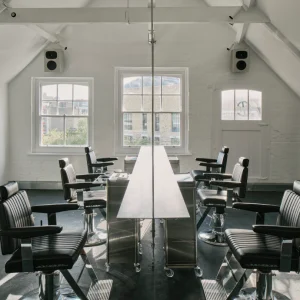Selfridge’s new designer womenswear floor in the Oxford Street store is like a sea of marble, in more ways than one. Jamie Fobert Architects as the designer used a black and white image of the sea, fading from the white of the sky through to the black of the sea, as a starting point for the scheme.
The practice, which had already completed the extremely successful women’s shoe department that sits adjacent, also wanted to ramp up the luxury to house the 10 key, upmarket, womenswear brands on show here.
Practice founder Jamie Fobert chose marble, which he says is normally rather ubiquitous and bland in department stores as it’s used to delineate all the walkways. He wanted to turn it back into something very special and create a gradated pattern swirling around the floor of the whole department, with a view to using the finest Italian marbles to complete it.
Once the creative concept was in place, Fobert went looking for the gradated marble in quarries above the Italian town of Pisa. He had in his mind’s eye a single mountainside that would have all the subtle variations he was looking for. ‘It turned out to be quite a lot more complicated than we originally thought!’ says Fobert. The practice ended up choosing from various sites, and photographs of pieces were being sent over to the UK as they were being cut.
During the laying, the stone would be dry placed in areas of 10 sq m at a time, and then the architects and designers would come in and move them around to get just just the right pattern they were after. The stone masons also soon got the hang of what they were trying to achieve, which helped make the project a little easier.
This scheme also involved stripping all of the store space right back to the shell and opening up the windows. The varying effects of daylight have been mitigated by a surprising move, which sees the marble floor sweeping vertically upwards for 2m along the perimeter. To avoid a sudden change in the translucency from the floor to the backlit marble, Fobert also placed a gradated film on the back of the vertical pieces to smooth out the transition.
Fobert says that the brands coming in ‘were universally keen on the scheme’ and many opted to do their own marble variations on a theme to fit in with the scheme’s original ethos and avoid simply delineating their areas.





